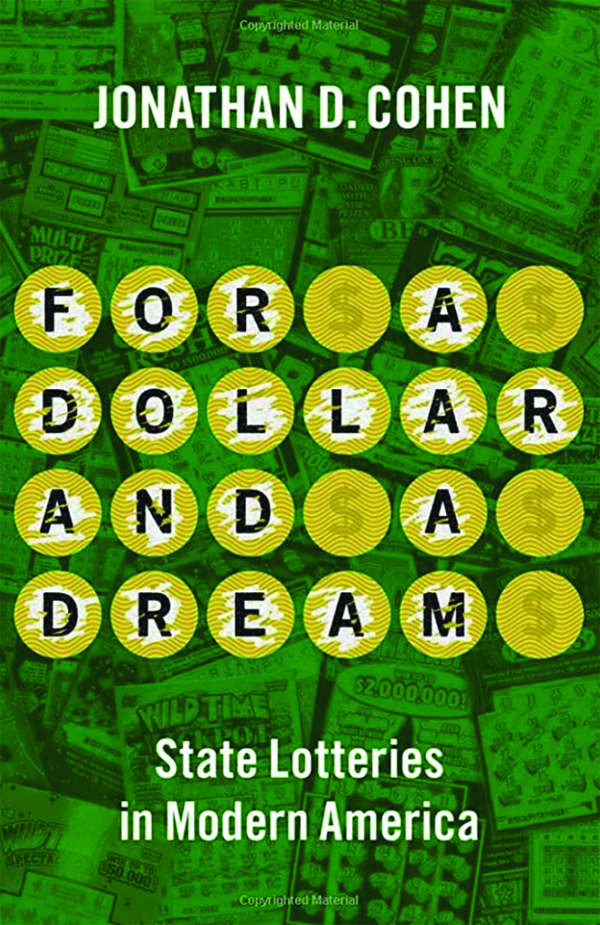
A new book that has the lottery’s number
Michael M. Rosen
For many lower-income Americans, the lottery “is more than just a game: It represents the likeliest path to financial stability, not to mention wealth,” Jonathan D. Cohen writes in For a Dollar and a Dream, his new book about the effects of state lotteries. Almost unbelievably, Cohen informs us, “In 2006, almost 40% of households with incomes under $25,000 believed their best means of accumulating several hundred thousand dollars in their lifetime was through the lottery.” Not even the COVID-19 pandemic could stop the games’ growth, which reached an astronomical $90 billion in nationwide sales in 2020. Only five states do not offer lotteries.

“Like gamblers themselves,” observed Richard Leone, one of nine members of the National Gambling Impact Study Commission, which published a 1999 study critical of state lotteries and other gaming enterprises, government officials “hope to get lucky and put off tough choices about taxes and spending by chasing increased gambling revenues.” Our nation’s deeply regressive lottery tickets, the study found, are far less rewarding than we think for buyers and sellers alike.
In this valuable new book, Cohen carries on the commission’s work, methodically and persuasively demonstrating how, despite their widespread popularity, state lotteries consistently prey on the underprivileged, corrupt state officials, and generate far less revenue than promised. Cohen, a writer, historian, and program officer at the American Academy of Arts and Sciences, collected data from some 30 archives across 18 states to map the metastasizing of state lotteries that began in earnest in the 1960s. He also conducts numerous interviews with lottery winners and losers that alarmingly illustrate the combustible mixture of hope and despair fueling the gambling craze.
The earliest lotteries appear in the Bible, and evidence exists in 1000 B.C. China of the reading of strewn animal bones. Ancient Rome saw the distribution of party favors to guests on the basis of drawings, and Nero himself awarded prizes to holders of winning raffle tickets. In 15th-century Flanders, lotteries funded city fortifications, while Venice and Elizabethan England used them to raise money for public works. The British predilection for such funding spread across the Atlantic. By 1791, a Boston newspaper observed that “every part of the United States abounds in lotteries.”
But the 19th and early 20th centuries witnessed an anti-gambling backlash among state and federal officials, if not necessarily among American citizens, who eagerly cottoned to informal, underground games of chance. Prominent among these, especially in inner-city African American communities in the Northeast, were “numbers games,” in which players selected a three-digit number that would be determined the next day by consulting publicly available sources, such as the last digit of the New York Clearing House’s daily clearings or of the total amount wagered at a given horse track. (One numbers game winner, Luther Theophilus Powell, parlayed his $10,000 jackpot into a new house in Queens for his wife and eventually renowned son, Colin.)
Yet, while the numbers games were generally fair, they gradually fell under the sway of organized crime. So when policymakers, especially in New Jersey, went looking for ways of funding schools and other state priorities without raising taxes, they found in lotteries a method of simultaneously curtailing the mafia’s malign influence. Proponents reasoned that if poor people were gambling anyway, they might as well contribute to state coffers while doing so.
But others resisted, concerned about the inherent regressiveness of the games. “It would be the worst of poor judgment,” thundered then-Gov. Richard Hughes (D-NJ) in 1968, “to believe that a lottery could do anything more than scratch the surface of our genuine requirement for funds.” Yet by 1972, 80% of New Jerseyans reported buying at least one ticket, and more than 90% approved of the lottery.
As lotteries began in the 1970s and ’80s to proliferate across the U.S., residents and politicians alike in the midst of various tax revolts began to see them as a panacea. Cohen notes that California adopted its lottery in 1984, just six years after the passage of Proposition 13, which curbed property tax hikes.
But it was when weekly lotto games adopted a seemingly minor change — allowing unwon prizes to carry over to the next week’s game, thus multiplying the size of the pot — that lotteries became truly turbocharged. The odds of winning a typical lotto game, Cohen amusingly informs us, only slightly exceed those of birthing identical quintuplets or becoming an astronaut. Nevertheless, states found that lengthening the odds, coupled with removing caps on prize totals, actually attracted more players. States banded together to boost jackpots. Maine, New Hampshire, and Vermont formed the Tri-State Lottery in 1982. Ten years later, Powerball began issuing tickets across 16 states. These larger consortia offer much longer odds, equivalent to the chances of releasing an ant into an area the size of four football fields, sticking a pin into a random spot, and impaling the ant.
The various state lotteries themselves weren’t shy about reinforcing through their advertising these tropes of democracy, fortune, and even meritocracy. “In America, we do not have kings or queens,” a 1990s California Lottery advertisement counseled. “What we have is something far more democratic. It’s called Super Lotto, and it gives each individual a chance for untold wealth. So, play Super Lotto, because even though you can’t be born a king, no one ever said you can’t live like one.” One Ohio Lottery executive said in 1975, “We don’t sell lottery tickets. We sell dreams,” while seven years later, the director of Michigan’s lottery called himself “the purveyor of dreams.”
Their ads targeted inner-city communities most likely to spend their hard-earned money on the futile exercise of gaming. In 1980, one Illinois Lottery official “anticipated that the game will be favorably accepted by the ethnic communities” and therefore expected that, when it came to advertising, “special emphasis will be placed against these communities.”
Just as lotteries grossly oversold their supposed merits to players, they severely exaggerated their benefits to schools. Some 70% of voters said in exit polls that they believed the lottery would support the state’s schools. And yet the games consistently generated less than 5% of California’s annual education budget. Worse, the legislature never bothered to sequester the funds for actual spending on schools — it simply trickled into the state’s general fund. Similar accounting tricks were (and are) played on voters in Florida and Georgia and other states.
Unfortunately, Cohen provides only a general outline of proposed reforms that might render the games less regressive and destructive. But For a Dollar and a Dream sheds vital light on a crucial problem bedeviling Americans, who waste far too much of their money pursuing an unreachable jackpot, and entrancing their representatives, who themselves have grown addicted to the lottery’s actually modest revenues. The 1999 national study recommended hitting an immediate pause on expanding gambling in the U.S. Instead, to our grave detriment, we fast-forwarded.
Michael M. Rosen is an attorney and writer in Israel and a nonresident senior fellow at the American Enterprise Institute.
